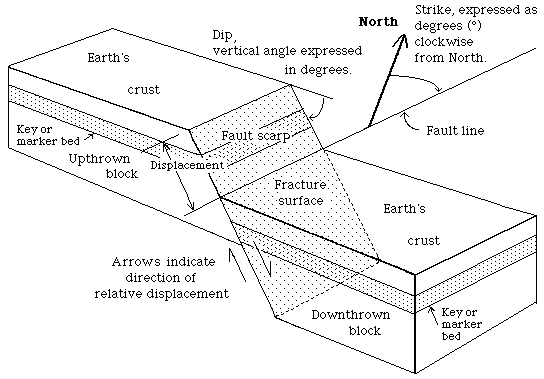Types of Faults
A fault is a fracture surface within the earth on which slip or
displacement has taken place. The total displacement on a fault may
be less than a few centimeters or may be measured in hundreds of
kilometers. Large displacements are commonly achieved by a series of
sudden slips associated with earthquakes, but under some conditions
involving slow slip, called creep. Many possible fault
configurations are possible; the fracture surface may be planar or
curved, and the slip may be uniform everywhere or may change from
place to place, as in a rotational displacement or a displacement
that becomes smaller and smaller and finally dies out. In this
report we will focus on those portions of faults with uniform
displacement on planar fracture surfaces and will not
discuss complex faults or the details associated with the edges or
intersections of faults.
The three fundamental fault types are normal, reverse, and
strike-slip. Normal faults involve a dipping fracture
surface on which the block above the fault plane, the hanging-wall
block, is downthrown with respect to the block below, called the
footwall block. Normal faults are common in regions of crustal
extension. In contrast, reverse fault displacements, which are
common in regions of compression, are such that the block above the
fracture surface is uplifted with respect to the block below.
--
Strike-slip faults generally involve no vertical motion, but instead
are produced by two blocks that are sliding laterally past one
another. The sense of lateral motion can be right lateral (dextral)
or left lateral (sinistral). Imagine that you are standing on one
side of the fault. If the other side has moved to the right, as may
be indicated by offset streams, ridges, roads, fences, or other
features that cross the fault, it is a right-lateral fault. If the
other side has been offset to the left, the fault is left lateral.
--
Few faults are, in fact, purely normal, reverse, or transverse, but
instead combine transverse motion with either normal or reverse
motion. This combined motion is termed oblique slip.
Complex fault types
When faults extend to the Earth's surface, displacing parts of
the landscape, landforms are developed or modified. The portion of
the fracture surface that is exposed by faulting is called the fault
scarp (figure 3). Fault scarps may initially be angular and well
defined, but over time they are modified by weathering and erosion
on the upper portions while the lower portions become buried by
eroded debris (talus). If a region is sliced by a series of
subparallel normal faults with sufficient displacement,
horst-and-graben topography may develop. A horst is a block that has
remained high relative to those on either side, whereas a graben is
depressed relative to the adjacent blocks (figure 4).

Source - Excerpts from: How to Construct Seven Paper Models that Describe Faulting of the Earth By Tau Rho Alpha and John C. Lahr - USGS
Simple fault types
Normal fault

Reverse fault

Right-lateral strike-slip fault

Left-lateral strike-slip fault

Oblique-slip fault

Complex Fault Types
Fault displacement decreases with depth and fault terminates in a fold

Fault surface is curved, resulting in block tilting

One block is rotated with respect to another
